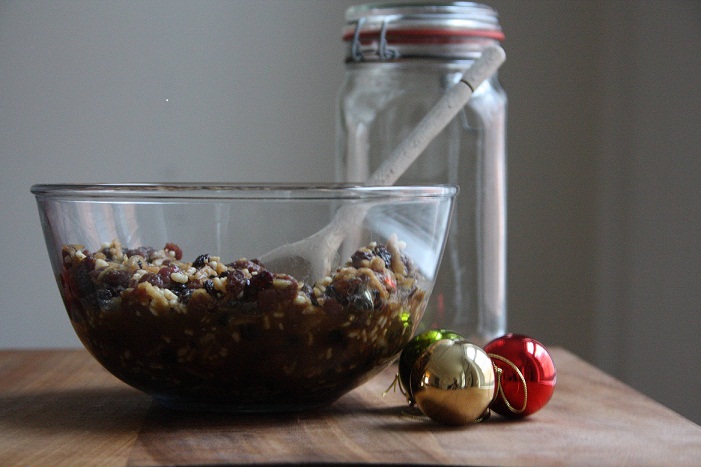A seasonal recipe for venison mincemeat, from the Dabbler’s foodie whizz Jassy, who also blogs at Gin and Crumpets.
The Christmas tree is up, half the Advent calendar doors stand gaping and the presents are a mess of wrapping paper and Sellotape, but there is still time to make your own mincemeat and have it ready for Christmas Eve.
The trajectory of the mince pie story is not an entirely happy one. They have their origins in the sweet and spicy Middle Eastern dishes that the Crusaders brought back to England in the 13th century. Originally long, oblong pies, they became smaller and smaller, were briefly banned as Popery in a pie crust and eventually lost their meatier elements in the Victorian era.
There is still, in theory, suet lurking in amongst the dried fruit, but these days that’s often replaced with vegetable shortening and the rich depth of flavour you can only get from animal fat is abandoned in favour of the easy pleasure of sugar.
The traditional meats for mincemeat are mutton, goose and ox tongue, but I’ve opted for venison for the vision of wintry decadence it conjures up in my mind. Buy venison steak and chop it finely – into chunks about ¼ of the size of your littlest fingernail – and if you can get it, use fresh beef suet.
When it comes to turning the mincemeat into mince pies, use all butter puff pastry and let them rest for a few minutes before serving them. They’re good by themselves or spread with thick cream or brandy butter.
Venison mincemeat
Makes approximately 1kg
225g venison steak, finely chopped
100g beef suet, finely chopped
150g dark brown muscovado sugar
150g currants
150g raisins
200g Bramley apple, peeled, cored and coarsely grated
Grated zest and juice of 1 lemon
1 tsp ground ginger
1 tsp ground cinnamon
¼ tsp ground cloves
1/8 nutmeg, finely grated
100ml brandy
1 Sterilise your jar(s) either by putting them through the dishwasher (making sure they sit and steam at the end of the cycle) or by washing them in very hot soapy water, rinsing and then heating them in an oven at gas mark 3/160°C/fan oven 140°C. If your using jam jars, boil the lids and dry.
2 Mix all the mincemeat ingredients together in a very large bowl and then spoon into the warm sterilised jar(s). Seal and store in the fridge for at least a week. It will keep well for about a month.
To turn into mince pies, preheat the oven to gas mark 4/180°C/fan oven 160°C. Roll out all butter puff pastry until it’s about as thick as a £1 coin and stamp out rounds using an 8cm cutter (a 375g pack of puff pastry will give you approximately 24 rounds). Line bun tins with half the rounds and fill with 2 tbsp mincemeat each. Brush the pastry edges with milk, cover with the remaining pastry rounds and press down to seal. Brush with milk to glaze and poke a small hole in the top of each pie. Bake for 25–30 minutes until risen and golden. Cool for about 10 minutes before serving warm.











I have just drooled all over my keyboard. Meaty mince pies – yum. Off to the butcher now for some deer. I can’t stand the overwhelming sweetness of the all-fruit version.
You will not regret it. I made mincemeat with beef last year and turned it into 24 mince pies, thinking that the guests wouldn’t be that mad keen on a meaty mince pie and it would just be a bit of a novelty. There was nearly a riot when it became apparent there weren’t enough mince pies for everyone. Meat, dried fruit and pastry are a surprisingly good and popular combination.
A Yuletide pasty, sounds delicious, tin miners take note. Mince pies, well into the “haven’tgotanymoreroomfor” category, tend to end up on the bird table.
I was inspired by venison pasties (the kind Peyps used to gorge on and then complain about: http://www.pepysdiary.com/archive/1662/09/06/) for this recipe. Could make these mince pies into a pasty shape. They might seem less mince pieish that way.
For me, it’s the Christmas pudding that ends up unwanted on our table. Such a heavy pudding to try and cram down after a heavy meal. I do try, but rarely succeed.
Of course, Malty, the size of “haven’tgotanymoreroomfor” category varies enormously from person to person, and depending on what’s on offer.
In terms of minimising the ‘haven’tgotanymoreroomfor’ category, I swear by the three Ps: Planning, Pacing and Pigging.
Not to mention an elasticated waistband.
We gave up years ago with puds Jassy, actually we eat mince pies all year round. This years Xmas special, German Goose, if it arrives / if junior remembers to buy one / if he doesn’t eat it raw on the trip over.
German goose of course, famous for their step.
looks divine!!! I hate fruity mince pies, so the posibility of eating a cute animal instead is a definate benefit.
How peculiar. I read this and was suddenly compelled to hunt down a book left to me by my grandmother (Woman’s Own Book of the Home 1931 ed). Inside the back cover, on a piece of browny-yellowy paper is scrawled her recipe for Christmas pudding, which I’ve been searching for years to find – so many thanks for inspiring me to look in a long forgotten cupboard. Nearly every recipe includes suet – perhaps you can explain a little more about this ingredient. Does suet have magical properties? Why isn’t it in common use today? And interesting also to note that other recipes offer sweet or savoury alternatives eg roly poly with either cold meat or jam.
By the way, said book is brilliant because everything’s in alphabetical order, so on the same page as ‘lentil cutlets’, you’ll find ‘letters to royalty, titled persons etc’. My favourite page is the one which includes ‘bilious attacks, to treat’ and ‘billiard tables, to iron.’ Most useful to know this sort of thing.
Susan, call me old-fashioned, but I used beef suet to make some dumplings for a beef stew only yesterday evening. That, however, is the limit to the use I make of this mysterious ingredient.
That book sounds absolutely brilliant. I was very fond of my mum’s copy of Mrs Beeton’s from the 1970s because of it’s instructive chapters on how best to address a bishop and what order to seat a duke, an earl and a lord.
Suet is the hard white fat that sits around beef and lamb’s kidneys (although you’ll be pushed to find lamb suet these days because it has such a strong lamby flavour, which people don’t often want in their pastry).
Obviously, you’re most likely to find it in boxes in the baking aisle, shredded and ready to go. If you’ve got a very good butcher, s/he’ll have some suet that they’ve rendered, cleared and chopped ready for use. If you’ve got quite a good butcher, they will let you buy some suet / give you some for free and you just need to clear it before you use it.
To clear it, you need to chop it into small, equal-sized pieces and put in a pan with a splash of water. Heat over a very low heat until it is liquid, then pour it through muslin to catch any blood or connective tissue. You can do this a second time if it still doesn’t seem clear. Then pour it into a heatproof tub and store in the fridge. Suet ready to go!
Uses are obviously steamed or boiled puddings, dumplings or pie crusts. Being beefy in origin, it’s the natural choice for beef pies and puddings and you could, for example, make a savoury jam roly poly with beef mince if you were looking for something interesting to make with it.
Why it fell out of favour – based on no research at all, I’d say it lost its popularity because it was seen as unhealthy (we all wented to eat nothing but margarine and then olive oil for a while) and also because steamed puddings and big pies take forever to make, so their inconvenient, and they were very unfashionable for a while. But they’re coming back into fashion now in restaurants, so maybe we’ll see a bit of a resurgence.
That book sounds splendid in its eclectic usefulness, Susan. I expect Frank Key would like a copy of that.
Try some Compass Box Orangerie (orange infused whisky – sounds vile but try it) with mince pies. Mmm.
You had me at whisky. Sounds perfect.
Suet Susan, still available by the bucket load from Forsyths the Peebles butchers, a legend in their own lunchtime. Nuthatch and Long Tailed Tits love it.
You can use shredded vegetable suet, which isn’t quite as toothsome but does the same job. Dumplings are very easy to make: mix self-raising flour and suet in a ratio of 2:1 (by weight), stick together with a bit of water and steam on top of your stew for 20 mins. They make a nice change from the usual round of carbs. Definitely not for the birds.